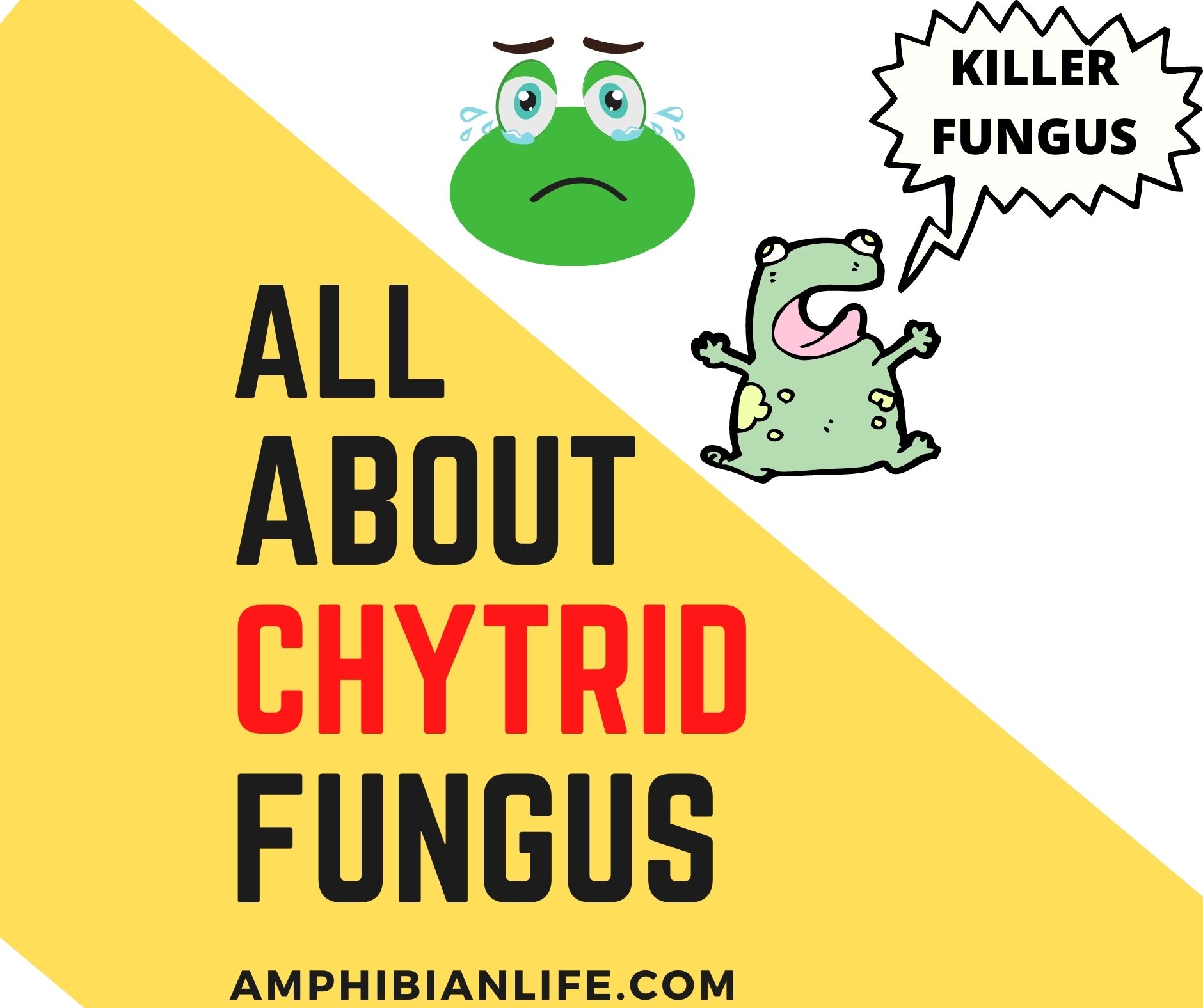
What Causes Chytridiomycosis In Frogs?
The Catastrophic Amphibian Chytrid Fungus was discovered and named in the late 1990s.
Since then, Chrytrid Fungus (Phylum Chytridiomycota) has wiped out dozens of amphibians species.
They as the primary cause of amphibian population declines and extinctions in Latin, North America, and Australia.
Are All Fungus Harmful?
The simple answer is both yes and no. There are many known varieties of “chytrid” fungi around the world, but most of them are decomposers of organic and plant matter. they are not life-threatening for either humans or amphibians.
But they may potentially convert into chytridiomycosis, but not all infected host amphibians develop it.
It is still unknown, Why a particular type of this fungus becomes pathogenic to amphibians;
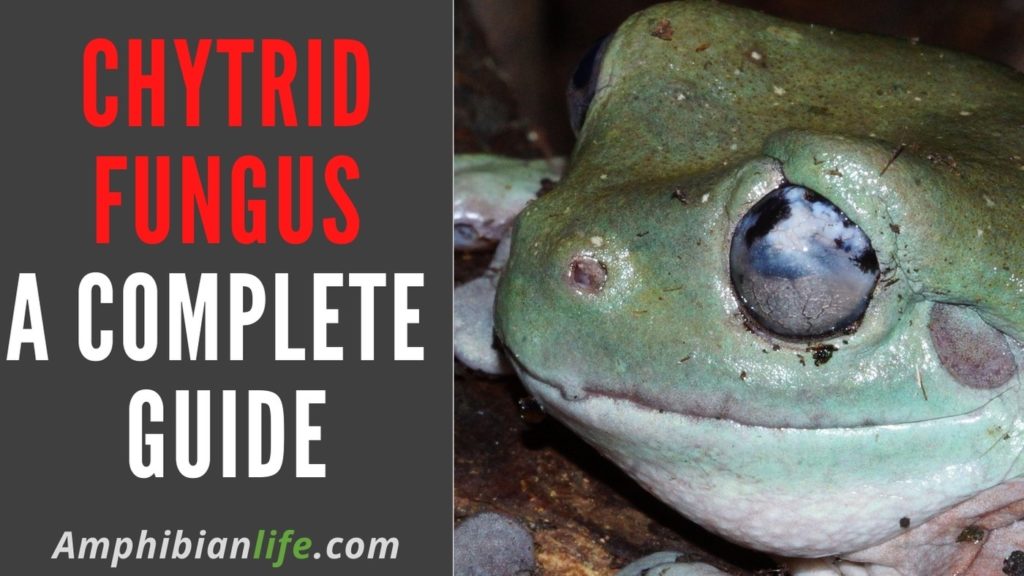
Discovery of chytrid fungus.
The fungus has spread to every continent except Antarctica and the earliest record frog specimens are from Africa in the 1930s.
In the mid-1980s a lot of amphibians got infection and die in vast numbers,
Dr. Karen Lips and his colleagues from Southern Illinois University are the first ones, to document it.
They find out the direct correlation between the arrival of chytrid fungus and loss of amphibian diversity.
Life Cycle of Chytrid Fungus in Amphibians:
- Spores in frog habitats swim towards healthy frogs and amphibians.
- Spores find their way to penetrate through their skin and develop into Thallus
- Mature fungus develops into an enclosure of spores called sporangium
- Spores are Released after 4-5 Days.
- Infected Atelopus (large genus of true toads) dies within 120 days.
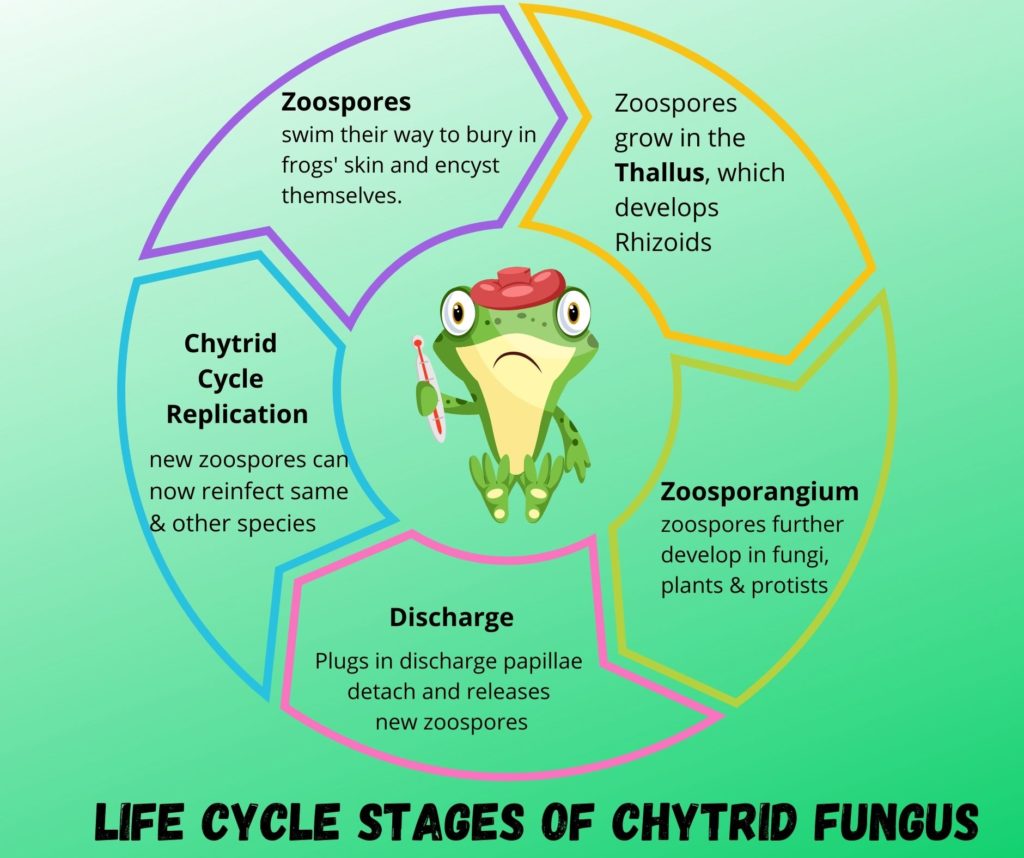
Deep Analysis of Chytrid Fungi Life Cycle.
- Zoospores=> Aquatic zoospores swim using flagella, A zoospores find the skin and bury and encyst themselves.
- Thallus => Zoospores grow in the thallus, which develops Rhizoids into the nearby cells, it extracts nutrients and begins to grow into more complex structures at a rapid rate.
- Zoosporangium =>Asexual structure formation (sporangium) in which the zoospores further develop in fungi, plants, or protists.
- The Thallus develops into a zoosporangium having a spherical mass.
- The Spherical mass begins and continues to divide.
- Finally, new Zoophores with a discharge tube called Pipillae with plugs are formed.
- Discharge=> The plugs on the discharge papillae detach and the zoosporangium releases new zoospores out of the skin.
- Chytrid Cycle Replication => The Newly releases zoospores can now reinfect the same organism until it dies or can infect and replicate the cycle on a new organism (mostly amphibians).
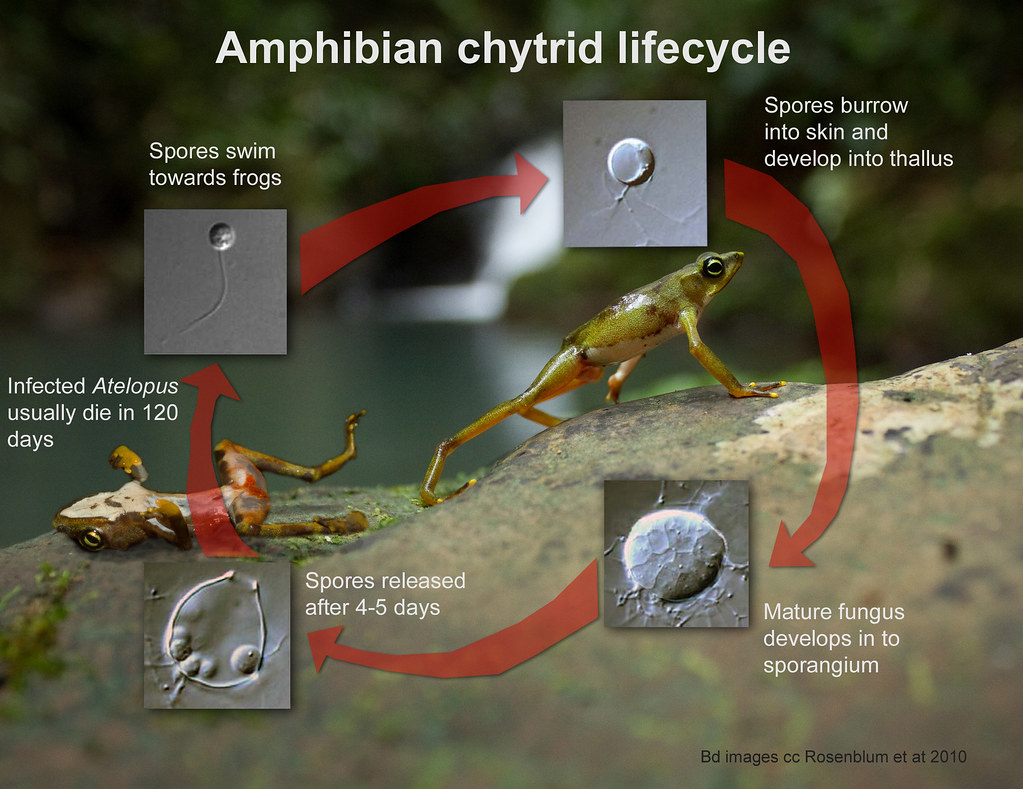
Source flickr.com
How does chytrid fungus kill Amphibians?
Chytrid fungus invades the thin, permeable skin of amphibians and appears to kill them by interrupting their ability to maintain the movement of water and oxygen through their skin.
In national parks and zoo’s feet or feathers of birds, insects, and frogs, are the main carrier of chytrid fungus.
They provide an easy way to transmit them via motile spore into protected habitats.
Treatment options, at present, includes anti-fungal drugs and heat therapy, but they are still prone to toxicity and side-effects.
What does chytridiomycosis do to frogs?
What does chytrid do to frogs? Well, The fungus attacks the keratin-rich parts of a frog’s skin,
Since frogs use their skin in respiration, this makes it difficult for the frog to regulate water and oxygen and hinders breathing.
The fungus also attacks the neural activity and damages the amphibian’s nervous system, making frogs to behave abnormal.
What is the Disease BD?
BD or (Batrachochytrium dendrobatidis) is an infectious disease of amphibians caused by fungus Batrachochytrium dendrobatidis.
Numerous lineages of Bd have been discovered, hypothetically the hybridization of different strains leads to the emergence of harmful pathogenic Bd strains.
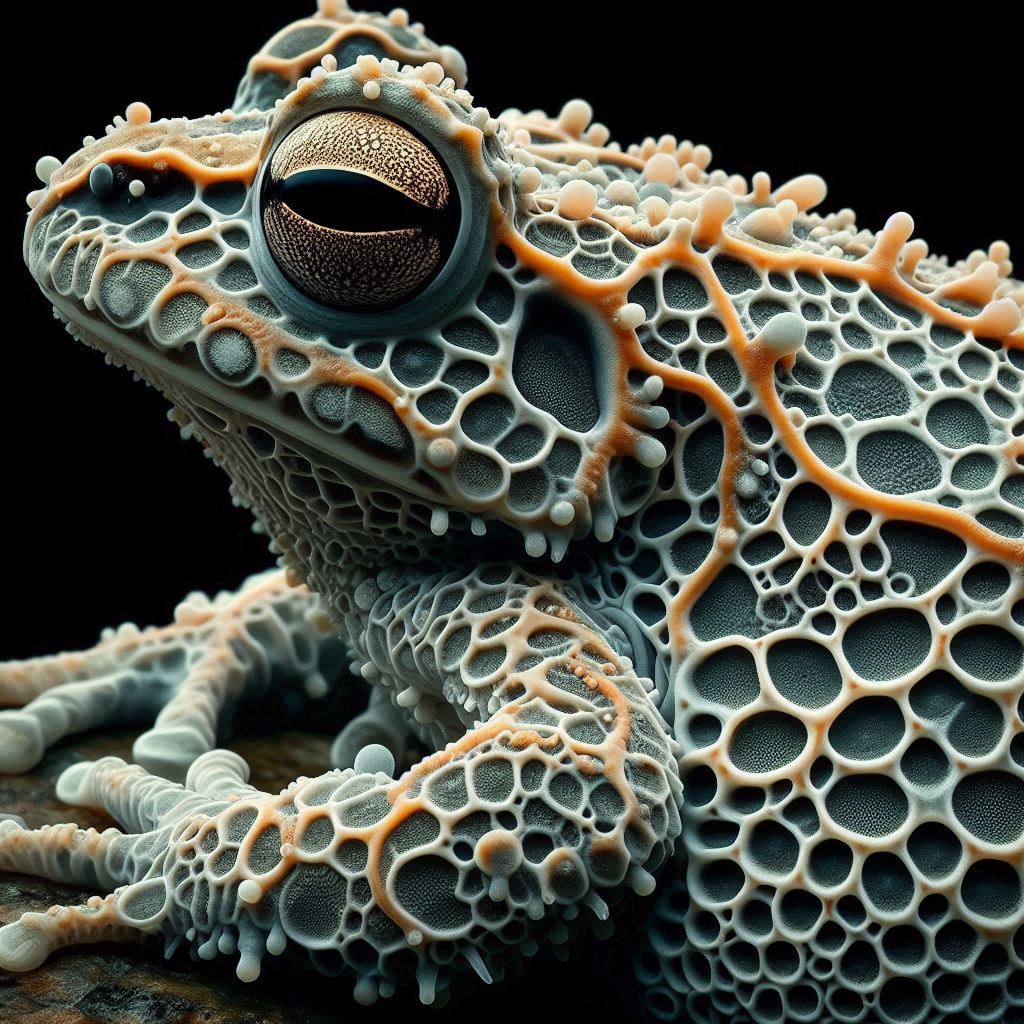
Chytrid fungus Symptoms? Diagnosis for Chytrid.
How is chytridiomycosis diagnosed? If your pet frog is feeling sick look for below visible physical changes
Note: Make sure you don’t get confused with shedding of frogs skin as its a usual behavior of frogs.
- Discoloration of the skin changes in textures that are not normal.
- Unusual Peeling, sloughing on outside layers of its skin
- Sitting out in the open, not protecting itself or hiding.
- Sluggish, lethargic behavior, and loss of appetite.
- The frog tends to spreads away from its legs, rather than keeping tucking them within its body.
- Patchy or roughness of the frog’s skin
In more extreme cases, the frog’s body becomes rigid, and its back legs trail behind it.
How chytrid fungus spreads in frogs?
The chytrid fungus only attacks the parts of a frog’s skin that have keratin in them.
But Tadpoles may get infection around their mouths, but this is not enough to kill them.
It’s only when they start turning into frogs, and grow keratin in other areas, that the Chytrid fungus can spread throughout their bodies.
They may then die from the disease; but not before they’ve hopped around, spreading the fungal spores to other ponds and streams.
Once a pond has become infected with chytrid fungus, the fungus may stay in the water forever.
This means it is very important not to move frogs from one area to another.
Stages of Chytrid Fungus Infection:
Stage 1: Infecting Tadpoles
Tadpoles only have keratin (shown in red) in their mouth area, so they can scrape algae and decaying vegetation from the bottom of a pond or stream.
Chytrid fungus only affects the interior and posterior parts of the mouth not other organs.
Stage 2: Infecting Froglets
As the tadpole develops legs, it grows keratin on its feet and hands, to make them stronger. Chytrid fungus present in water can infect new areas of keratin.
Stage 3: Infecting Adult Frogs
When tadpoles develops into a froglet, and keratin grows on other body parts to protect it from wear and tear.
Now, It facilitates Chytrid fungus to spread to many parts of the frog’s body.
How to stop the spread of chytrid fungus?
Take below precautions while visiting frog habitats in the wild, including nature pond, zoo or backyard gardens:
- Touch frogs only when it’s necessary as a medical examination or while feeding.
- Use protective gears while handling them such as disposable gloves, poly bags, and sterilized equipment.
- Clean and disinfect clothes or all things that come in physical contact between frog sites visit.
- If you are handling them in the zoo, garden, or any outdoor facility, wash your vehicle tires properly.
- Avoid moving or relocating frogs to fresh areas or new vivarium
- Don’t mix healthy species with unhealthy or infectious frogs.
- Use Clean Utensils and a disinfectant while working between potential threats place.
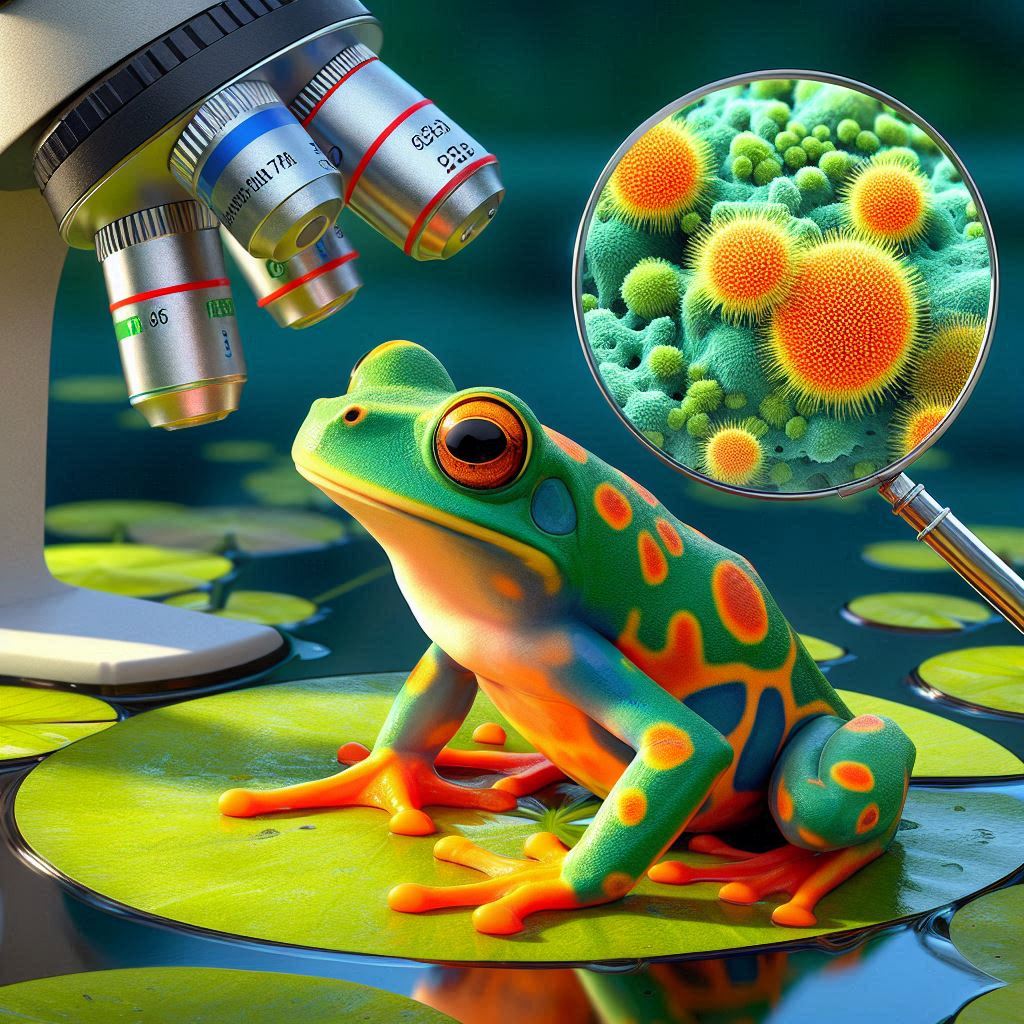
How do you get rid of chytrid fungus?
Chytrid fungus Drug treatment?
The experimental treatments: These Include commercial antifungal products (itraconazole, steriplantN, mandipropamid, and PIP Pond Plus), Antimicrobial skin peptides of Pelophylax esculentus, microbial agents (Pedobacter cryoconitis), and heat therapy (at 35°C for a day) are suggested.
What is a Cure for chytrid?
The fungus is treatable in captivity using Itraconazole, a fungicide similar in chemical properties in Foot medication of Athlete’s.
Unfortunately, in the wild, the condition is not curable on its own, fungicide spray is not readily available in rainforest.
What to do if you find a sick frog?
If you think you’ve found a sick frog, or if you see a frog that has died recently for no obvious reason.Follows as below:
- Place the frog into a sterile container (wash and disinfect any glass or plastic bottle ) without touching it.
- If the frog is still alive and moving, make sure to make an escape-proof breathable enclosure with some water.
- If the frog is dead, put the container into a plastic bag and put it in a freezer as quickly as possible
- Transport the frozen or live frogs by courier, and get respective expense reimbursements.
For Further Reading
I hope that you have learned a lot about The Term “Chytrid.
This post increases your awareness about frog diseases and how to keep your frog healthy?
Monitor your frog’s heath and changes in its skin pattern, whether it is usual shedding or some infection.
If you found this article helpful and you enjoyed reading it, Check some other related articles below.
Here’s an interesting article How to Deter Amphibians from Your Garden (10 Easy Ways)
Here’s another Good article about amphibian’s poop and diseases they carry.
